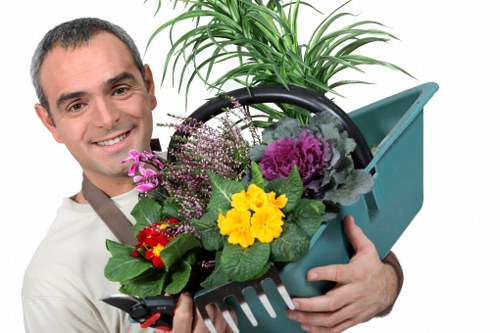Hedge Trimming in Wimbledon
Introduction to Hedge Trimming

Hedge trimming is a fundamental aspect of garden maintenance that ensures your shrubs and hedges remain healthy, attractive, and well-shaped. In Wimbledon, where picturesque gardens and manicured landscapes are highly valued, proper hedge trimming is essential for both residential and commercial properties.
Whether you're a homeowner aiming to enhance your property’s curb appeal or a business seeking to present a professional exterior, understanding the nuances of hedge trimming in Wimbledon can significantly impact the overall aesthetic and health of your outdoor spaces.
This comprehensive guide delves into the best practices, techniques, and considerations for hedge trimming, ensuring that your hedges not only look their best but also thrive year-round.
Why Hedge Trimming Matters

Regular hedge trimming serves multiple purposes beyond mere appearance. It plays a crucial role in maintaining the health of your plants by removing dead or diseased branches, encouraging new growth, and preventing overgrowth that can lead to structural problems.
In Wimbledon’s climate, which experiences a mix of temperate conditions and sporadic rainfall, proper hedge maintenance helps safeguard your plants against potential weather-related stress. Moreover, well-maintained hedges can act as natural barriers, providing privacy, reducing noise pollution, and enhancing the overall value of your property.
Neglecting hedge trimming can result in unsightly overgrown shrubs, increased susceptibility to pests and diseases, and diminished property aesthetics. Therefore, incorporating regular trimming into your garden maintenance routine is indispensable for sustaining vibrant and robust hedges.
Techniques for Effective Hedge Trimming

Mastering the art of hedge trimming involves understanding various techniques that cater to different types of hedges and desired outcomes. Here are some essential methods:
Shearing
Shearing is the most common method for creating uniformly shaped hedges. It involves using hedge trimmers or shearing tools to trim the sides and top of the hedge to a desired shape and size. This technique is ideal for formal gardens where precision and symmetry are paramount.
Blunt Cutting
Blunt cutting involves making straight cuts across the entire hedge to maintain its natural shape. This technique encourages bushier growth and is suitable for less formal gardens where a more natural appearance is desired.
Rejuvenation Pruning
For overgrown or neglected hedges, rejuvenation pruning can help revive their health and appearance. This method involves cutting back the hedges significantly, often to ground level, to stimulate new growth and restore the plant’s vigor.
Choosing the Right Technique
Selecting the appropriate trimming technique depends on the type of hedge, its growth pattern, and the desired aesthetic. It's essential to assess these factors before deciding on the method to ensure the best results.
Consulting a Professional
If you're unsure about which technique to use, consulting a professional hedge trimmer in Wimbledon can provide valuable insights and ensure your hedges receive the proper care they need.
Essential Tools and Equipment

Equipping yourself with the right tools is crucial for efficient and effective hedge trimming. Here's a list of essential equipment:
- Hedge Trimmers: Available in electric, battery-powered, or gas-powered models, these are ideal for trimming larger hedges quickly.
- Pruning Shears: Perfect for detailed work and trimming smaller branches.
- Loppers: Provide the necessary leverage for cutting thicker branches that shears can't handle.
- Gloves and Protective Gear: To protect your hands and eyes during the trimming process.
- Ropes and Stakes: Useful for guiding the shape of the hedge or supporting branches.
Investing in high-quality tools not only makes the trimming process easier but also ensures cleaner cuts, promoting healthier regrowth.
Regular maintenance of your tools, such as sharpening blades and cleaning equipment after use, extends their lifespan and maintains their efficiency.
Safety Measures During Hedge Trimming

Hedge trimming can be hazardous if proper safety measures are not observed. To ensure a safe trimming experience, consider the following precautions:
- Wear Protective Gear: Always wear gloves, safety glasses, and sturdy footwear to protect against potential injuries from sharp tools and falling branches.
- Inspect Tools Before Use: Ensure that all equipment is in good working condition. Check for loose parts, sharp blades, and adequate fuel levels if using gas-powered trimmers.
- Be Mindful of Your Surroundings: Keep bystanders and pets at a safe distance. Be aware of overhead wires and other obstacles that could pose risks during trimming.
- Use Proper Techniques: Maintain a balanced stance and avoid overreaching to prevent falls or tool mishandling.
- Take Regular Breaks: Hedge trimming can be physically demanding. Taking breaks helps prevent fatigue, reducing the risk of accidents.
By following these safety guidelines, you can minimize the risk of injury and ensure a more efficient and enjoyable hedge trimming experience.
Additionally, it's essential to be trained or informed about the correct use of each tool to prevent mishaps and achieve the best trimming results.
Optimal Timing for Hedge Trimming

Timing is a critical factor in hedge trimming. The best time to trim your hedges in Wimbledon depends on the type of plant and the desired outcome.
Spring Trimming: Ideal for promoting growth after the winter dormancy period. It's the best time for rejuvenation pruning and shaping before the growing season begins.
Summer Trimming: Suitable for maintaining shape and controlling growth. It's also a good time to perform light pruning to manage the size of the hedges.
Autumn Trimming: Useful for preparing hedges for the winter. Trimming in autumn can help prevent damage from heavy snow or frost.
Avoid Trimming in Late Summer or Early Fall: Trimming during this period can stimulate new growth that may not harden off before winter, leading to potential damage.
Understanding Plant-Specific Needs
Different hedge plants have varying trimming requirements. For instance:
- Boxwood Hedges: Prefer light, frequent trimming to maintain their shape.
- Privet Hedges: Can tolerate more aggressive trimming and are ideal for formal hedges.
- Yew Hedges: Respond well to both shearing and pruning, allowing for diverse shaping options.
Researching the specific needs of your hedge plants ensures that you trim them at the optimal time and using the appropriate techniques.
Seasonal Considerations
Understanding the seasonal changes in Wimbledon helps in planning your hedge trimming schedule. The temperate climate allows for consistent growth, but unexpected weather patterns can affect the best times to trim.
Climate Impact
Wimbledon's climate, characterized by mild winters and warm summers, provides a favorable environment for hedge growth. However, variations in rainfall and temperature should be considered when scheduling your trimming activities.
Local Regulations and Guidelines

When trimming hedges in Wimbledon, it's essential to be aware of local regulations and guidelines. These rules are designed to maintain the area's aesthetic standards and ensure environmental sustainability.
Some key considerations include:
- Height Restrictions: Certain areas may have restrictions on the maximum height your hedges can reach, especially near roads or public spaces.
- Protected Species: Some hedges may contain protected plant species that require special handling and trimming practices.
- Permits for Large-Scale Trimming: For extensive trimming projects, you may need to obtain permits from local authorities.
Environmental Considerations
Adhering to environmental guidelines helps preserve the local ecosystem. Proper hedge trimming can support biodiversity by encouraging the growth of various plant species and providing habitats for wildlife.
Noise Regulations
Using power tools for hedge trimming can generate significant noise. Be mindful of local noise regulations, especially during early morning or late evening hours.
Waste Disposal
Trimming hedges produces organic waste. Follow local guidelines for disposing of clippings and branches, which may include composting or using designated green waste collection services.
Professional Hedge Trimming Services vs. DIY

Deciding between hiring professional hedge trimmers or undertaking the task yourself depends on various factors such as the size of your hedges, your expertise, and the desired results.
Benefits of Hiring Professionals
- Expertise: Professionals have the training and experience to handle different hedge types and ensure precise trimming.
- Time-Saving: Outsourcing the task frees up your time for other activities.
- Quality Results: Professionals use specialized tools and techniques to achieve a polished and uniform appearance.
- Safety: Experienced trimmers are adept at managing the risks associated with hedge trimming, ensuring a safe process.
Advantages of DIY Hedge Trimming
- Cost-Effective: Doing it yourself can save money on service fees.
- Personal Satisfaction: Many find personal satisfaction in maintaining their gardens.
- Flexibility: You can trim your hedges according to your schedule and preferences.
Making the Right Choice
Consider the complexity and scale of your trimming needs, your budget, and your personal expertise when deciding between professional services and DIY trimming.
Hybrid Approach
Some homeowners opt for a hybrid approach, handling minor trimming themselves while hiring professionals for more extensive or specialized tasks.
Benefits of Professional Hedge Trimming

Hiring professional hedge trimmers in Wimbledon offers numerous advantages that can enhance the health and appearance of your hedges.
- Experienced Hands: Professionals understand the intricacies of hedge care, ensuring that each plant receives the appropriate treatment.
- Access to Advanced Tools: They utilize high-quality, specialized equipment that can handle various trimming demands efficiently.
- Customized Services: Professionals can tailor their services to meet your specific aesthetic and maintenance goals.
- Consistent Maintenance: Regular professional trimming ensures that your hedges remain in optimal condition throughout the year.
Moreover, professionals can provide valuable advice on the best practices for ongoing hedge care, helping you maintain their beauty and vitality.
Investing in professional hedge trimming not only enhances the immediate appearance of your garden but also contributes to the long-term health and sustainability of your plants.
Common Hedge Trimming Mistakes to Avoid

Even with the best intentions, certain mistakes can undermine your hedge trimming efforts. Here are common pitfalls to be aware of:
- Over-Trimming: Cutting back too much can stress the plant and impede future growth.
- Ignoring Plant Growth Patterns: Not understanding the natural growth direction can lead to uneven or unnatural shapes.
- Using Dull Tools: Dull blades can cause jagged cuts, leading to disease and poor regrowth.
- Neglecting Regular Maintenance: Infrequent trimming can result in overgrown hedges that are harder to manage.
Preventing Mistakes
To avoid these common errors:
- Plan Your Trimming: Decide on the desired shape and size before you begin.
- Understand Your Plants: Research the specific needs and growth patterns of your hedges.
- Maintain Your Tools: Keep your trimming tools sharp and well-maintained.
- Trim Regularly: Incorporate hedge trimming into your regular garden maintenance schedule.
Seeking Guidance
If you're uncertain about the best trimming practices, consulting with a professional can provide clarity and prevent costly mistakes.
Continuous Learning
Stay informed about the latest hedge trimming techniques and best practices by reading gardening literature or attending workshops.
Maintaining Your Hedges Post-Trimming

Proper maintenance after trimming is crucial for the ongoing health and appearance of your hedges. Here are some maintenance tips:
- Watering: Ensure your hedges receive adequate water, especially during dry periods, to promote healthy regrowth.
- Fertilizing: Apply appropriate fertilizers to provide essential nutrients that support growth and resilience.
- Pest Control: Regularly inspect your hedges for signs of pests or diseases and take action promptly if issues arise.
- Mulching: Apply mulch around the base of your hedges to retain moisture and suppress weeds.
Consistent maintenance helps your hedges recover from trimming and maintains their lush, vibrant appearance.
Additionally, monitoring your plants allows you to address any emerging issues before they escalate, ensuring long-term health and beauty.
Monitoring Growth
Keep an eye on new growth patterns to identify any irregularities or potential problems early on. This proactive approach enables timely interventions and supports continuous plant health.
Seasonal Adjustments
Adjust your maintenance routine based on seasonal changes. For example, reduce watering in wetter months and increase it during dry spells.
Benefits of Ongoing Care
Regular upkeep not only enhances the visual appeal of your hedges but also contributes to their structural integrity and disease resistance.
Seasonal Hedge Trimming Tips

Adapting your hedge trimming practices to the seasons ensures that your hedges remain healthy and well-shaped throughout the year.
Spring
Spring is the perfect time for rejuvenation pruning. Remove any dead or damaged branches to stimulate new growth. This period sets the stage for a vibrant growing season.
Summer
During summer, focus on maintaining the shape and controlling the size of your hedges. Light trimming can prevent overgrowth and help manage the plant's energy distribution.
Autumn
Autumn trimming helps prepare your hedges for winter. Remove any last-minute growth and tidy up the structure to minimize potential damage from harsh weather conditions.
Winter
While hedge trimming is generally performed in other seasons, winter can be a suitable time for certain maintenance tasks, such as cleaning and tool maintenance. Avoid heavy trimming during this period to prevent stress on the plants.
Adjusting Techniques
Each season may require slight adjustments in your trimming techniques to align with the plant's growth cycles and environmental conditions.
Season-Specific Tools
Using different tools or blade types during various seasons can enhance the effectiveness of your trimming efforts, ensuring optimal results.
Eco-Friendly Practices in Hedge Trimming

Incorporating eco-friendly practices into your hedge trimming routine contributes to environmental sustainability and promotes healthy plant growth.
- Use Electric or Battery-Powered Tools: These produce fewer emissions compared to gas-powered equipment, reducing your carbon footprint.
- Compost Clippings: Recycling hedge trimmings by composting them enriches your soil and reduces waste.
- Choose Native Plants: Native hedge plants are more resilient and require less maintenance, conserving water and preserving local biodiversity.
- Implement Water-Efficient Practices: Mulching and proper watering techniques minimize water waste and support plant health.
Adopting these green practices not only benefits the environment but also contributes to the longevity and vitality of your hedges.
Moreover, eco-friendly hedge trimming aligns with the growing emphasis on sustainable gardening, making your property a model of environmental responsibility.
Reducing Chemical Use
Limit the use of chemical fertilizers and pesticides by opting for organic alternatives. This approach fosters a healthier ecosystem and protects beneficial insects and wildlife.
Energy Conservation
Maintaining your tools and using energy-efficient equipment reduces overall energy consumption, supporting broader environmental conservation efforts.
Beneficial Wildlife
Proper hedge trimming can create habitats for various wildlife species, promoting biodiversity and enhancing your garden's ecological balance.
Choosing a Hedge Trimming Service in Wimbledon

Selecting a reliable and professional hedge trimming service in Wimbledon ensures that your hedges receive the best possible care. Here's what to consider:
- Experience and Expertise: Look for companies with a proven track record and knowledgeable staff.
- Customer Reviews: Positive testimonials and reviews can indicate the quality of service you can expect.
- Comprehensive Services: Choose a service that offers a range of maintenance options, from trimming and pruning to pest control and fertilization.
- Pricing Transparency: Clear and fair pricing structures help you avoid unexpected costs.
- Insurance and Licensing: Ensure the company is properly insured and licensed to operate in Wimbledon.
Requesting Quotes
Obtain multiple quotes to compare services and pricing. This comparison helps you make an informed decision based on your budget and specific needs.
Evaluating Proposals
Carefully review each proposal, considering the scope of work, timeline, and any additional services offered. Ensure that the service aligns with your expectations and requirements.
Local vs. National Providers
Local hedge trimming services in Wimbledon may offer more personalized attention and a better understanding of the local climate and plant varieties compared to national providers.
Cost Factors in Hedge Trimming

The cost of hedge trimming in Wimbledon can vary based on several factors. Understanding these elements helps you budget effectively and ensures you receive value for your investment.
- Hedge Size and Density: Larger and denser hedges require more time and resources, impacting the overall cost.
- Trimming Frequency: Regular maintenance may offer cost savings in the long run by preventing overgrowth and reducing the need for extensive trimming.
- Complexity of the Job: Intricate shapes or hard-to-reach areas may require specialized tools or additional labor, affecting pricing.
- Service Provider: Established and reputable services may charge higher rates, reflecting their expertise and quality of work.
Getting the Best Value
To maximize value, opt for services that offer comprehensive care and flexibility in scheduling. Comparing multiple providers and understanding what each quote includes can help you make a cost-effective choice.
Seasonal Discounts and Offers
Many hedge trimming services offer seasonal discounts or bundled services. Taking advantage of these offers can reduce costs while ensuring your hedges receive professional attention.
Long-Term Contracts
Entering into a long-term maintenance contract with a service provider can provide consistent care for your hedges at a discounted rate, benefiting both your budget and your garden's upkeep.
Eco-Friendly Hedge Trimming Solutions

Eco-friendly hedge trimming solutions are increasingly popular among Wimbledon residents and businesses alike. These sustainable practices not only benefit the environment but also promote healthier plant growth.
- Manual Tools: Using hand-powered tools reduces carbon emissions and noise pollution compared to electric or gas-powered equipment.
- Organic Treatments: Employing organic fertilizers and pest control methods supports a healthy ecosystem and reduces chemical runoff.
- Sustainable Waste Management: Composting hedge clippings and utilizing them as natural fertilizers enhances soil quality and minimizes waste.
- Water Conservation: Implementing efficient watering systems, such as drip irrigation, ensures that your hedges receive adequate moisture without excessive water use.
Integrating these sustainable practices into your hedge trimming routine contributes to a greener and more environmentally responsible garden.
Moreover, eco-friendly approaches often result in healthier plants, as they rely on natural processes and materials that support robust growth.
Benefits of Sustainability
Adopting sustainable hedge trimming practices not only preserves the environment but also aligns with broader community efforts towards conservation and responsible gardening.
Community and Environmental Impact
Your eco-friendly gardening choices can inspire neighbors and contribute to the overall environmental health of the Wimbledon community.
Continuous Improvement
Staying informed about the latest eco-friendly gardening techniques ensures that your hedge trimming practices remain sustainable and effective.
Choosing the Right Type of Hedge

Selecting the right type of hedge is fundamental to achieving the desired appearance and functionality. Wimbledon offers a variety of hedge plants, each with unique characteristics and maintenance requirements.
- Privet: Known for its dense foliage and adaptability, privet is ideal for creating formal hedges and privacy screens.
- Boxwood: A classic choice for elegant, formal hedges, boxwood is prized for its small, evergreen leaves and slow growth.
- Yew: Yew hedges are highly versatile and can be shaped into intricate designs, thriving in both sun and shade.
- Laurel: With its large, glossy leaves, laurel hedges are excellent for creating thick, impenetrable barriers.
- Hornbeam: Hornbeam hedges are deciduous but retain their structure throughout the year, providing seasonal interest and privacy.
Factors to Consider
When choosing a hedge type, consider factors such as growth rate, longevity, maintenance needs, and the overall aesthetic you wish to achieve.
Climate Compatibility
Ensure that the hedge species you select are well-suited to Wimbledon’s climate, flourishing under its temperature and precipitation patterns.
Soil Health
Different hedge plants have varying soil requirements. Testing your soil’s pH and nutrient levels can help you select the most compatible hedge type.
Hedge Trimming Best Practices

Implementing best practices in hedge trimming ensures not only aesthetically pleasing results but also the long-term health of your plants.
- Trim at the Right Time: Align your trimming schedule with the plant’s growth cycle for optimal results.
- Use Sharp Tools: Clean, sharp blades make precise cuts and reduce stress on the plants.
- Shape Consistently: Maintain a uniform shape by trimming evenly across the entire hedge.
- Remove Dead or Diseased Branches: Trimming these branches prevents the spread of diseases and promotes new growth.
- Don’t Overlook the Base: Ensure that the base of the hedge is trimmed to encourage upward growth and prevent encroachment.
Maintaining Trim Quality
Focus on making clean, precise cuts at a slight angle to facilitate water runoff and prevent disease. Avoid tearing or crushing the branches, which can damage the plant and invite pests.
Regular Inspection
After trimming, inspect your hedges for any signs of stress or damage. Addressing issues promptly ensures your hedges recover quickly and continue to thrive.
Record-Keeping
Maintain a log of your trimming activities, noting dates, techniques used, and observations about plant health. This record helps in planning future maintenance and identifying any recurring issues.
Conclusion

Effective hedge trimming in Wimbledon is a blend of art and science, requiring the right techniques, tools, timing, and care. Whether you choose to undertake the task yourself or hire professional services, prioritizing the health and aesthetics of your hedges ensures that your garden remains a beautiful and thriving space year-round.
By following the best practices outlined in this guide, you can achieve well-maintained hedges that enhance your property's appeal and contribute to a sustainable and vibrant garden environment.
Contact us today to schedule your professional hedge trimming service in Wimbledon and keep your garden looking its best!